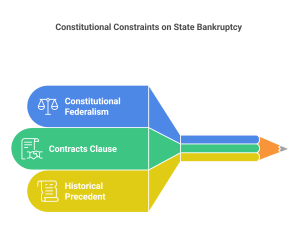Key Takeaways
- Legal Reality: States cannot legally declare bankruptcy under current U.S. law. Instead, they face alternatives like fiscal emergencies, debt restructuring, federal intervention, and austerity measures when experiencing severe financial distress.
- Financial Impact: State fiscal crises directly affect investments (particularly bonds), retirement benefits, property values, and tax burdens. Bondholders may face restructuring or delayed payments, while pensioners could see benefit modifications despite constitutional protections.
- Essential Services: During financial crises, states typically reduce public services, affecting education, public safety, and infrastructure. Citizens should stay informed about their state’s fiscal health, diversify investments, supplement retirement savings, and prepare for potential tax increases as protective measures.
Introduction
The phrase “state bankruptcy” sends shivers down the spines of investors, public employees, and taxpayers alike. As state debt levels have fluctuated over recent years, concerned citizens increasingly wonder: What would actually happen if a U.S. state couldn’t pay its bills? While corporations and municipalities have clear bankruptcy procedures, the situation for states is far murkier—and potentially more consequential for everyday Americans.
Whether you’re worried about your municipal bond investments, your state pension, or simply the continuation of essential services in your community, understanding the realities of state financial crises is critical in today’s economic landscape. Let’s dive into what state “bankruptcy” really means, and how it could impact your financial future.
Can a State Legally Declare Bankruptcy in the United States?
The short answer: No, they cannot.
Unlike cities and counties, U.S. states cannot legally file for bankruptcy under current federal law. Chapter 9 of the U.S. Bankruptcy Code allows municipalities (cities, towns, counties, and special districts) to restructure their debts, but this option isn’t available to states themselves.
This prohibition stems from constitutional principles:
- State sovereignty is protected under the 10th Amendment
- The Contracts Clause limits states’ ability to discharge debts
- Federal bankruptcy jurisdiction over sovereign states raises federalism concerns
What Actually Happens When States Can’t Pay Their Debts?
Since formal bankruptcy isn’t an option, states in fiscal crisis typically face a complex set of alternatives:
Fiscal Emergency Declarations
Most states have constitutional provisions allowing for the declaration of fiscal emergencies. These declarations grant governors or legislatures expanded powers to:
- Freeze spending
- Implement emergency tax measures
- Temporarily suspend certain financial obligations
- Appoint emergency financial managers
Default and Debt Restructuring
Though rare, states can effectively default on their obligations by:
- Missing bond payments
- Negotiating with creditors for reduced payments
- Extending repayment timelines
- Implementing “haircuts” (reduced payments) on certain obligations
Federal Intervention
The federal government may step in through:
- Direct bailouts (though historically limited)
- Special loan programs
- Conditional financial assistance packages
- Technical support through Treasury or Federal Reserve mechanisms
Austerity Measures
Most commonly, states implement painful budget cuts:
| Typical Austerity Measure | Potential Impact |
| Workforce reductions | Reduced public services, higher unemployment |
| Benefit/pension changes | Lower income for retirees, legal challenges |
| Infrastructure spending cuts | Deteriorating roads, bridges, public facilities |
| Education funding reductions | Larger class sizes, fewer programs, higher tuition |
| Healthcare service cuts | Reduced access, longer waits, fewer covered services |
Has Any U.S. State Ever Gone Bankrupt?
While no state has formally “gone bankrupt” (since it’s legally impossible), several have experienced severe fiscal crises that offer important lessons.
Historical Near-Defaults
- Arkansas (1933): Defaulted on highway bonds during the Great Depression
- Eight states (1841-1842): Including Pennsylvania and Maryland, defaulted on canal and infrastructure bonds
- Illinois (2017): Came dangerously close to junk bond status amid budget impasse
- Puerto Rico (2016): While a territory rather than a state, Puerto Rico’s debt crisis required special congressional intervention
The Modern Experience: Budget Crises
Modern state fiscal crises typically involve:
- Credit rating downgrades (increasing borrowing costs)
- Payment prioritization (deciding which obligations get paid first)
- Protracted political battles over spending and taxation
- Service reductions affecting citizens’ daily lives
What Role Does the Federal Government Play If a State Faces Bankruptcy?
The federal government walks a delicate line between assisting states and respecting their sovereignty. Their involvement typically includes:
Limited Direct Intervention
The federal government has historically been reluctant to directly bail out states, fearing moral hazard (encouraging risky behavior) and setting problematic precedents.
Conditional Assistance
Federal aid generally comes with strings attached:
- Requirements for fiscal reforms
- Oversight mechanisms
- Structural changes to state finances
- Transparency and reporting obligations

Legal Framework
Legal Framework While Congress has created restructuring laws for territories, no equivalent framework exists for states.
How Would State Financial Crisis Affect Your Investments?
For investors, a state’s fiscal crisis creates ripple effects across multiple asset classes:
State-Issued Bonds
Bond investors face several risks during fiscal emergencies:
- Default risk: While rare, states could miss payments
- Restructuring risk: Bondholders might be forced to accept less favorable terms
- Market value declines: Even without default, bond prices typically fall amid concerns
- Liquidity challenges: It can become difficult to sell bonds of financially troubled states
Notably, general obligation (GO) bonds—backed by the state’s “full faith and credit”—typically receive higher payment priority than other obligations during crises.
Municipal Bonds
Local government bonds face unique risks when states struggle:
- Intergovernmental revenue cuts: States often reduce aid to localities
- Contagion effects: Investor fears about the state can spread to its municipalities
- Higher borrowing costs: Credit rating agencies often downgrade local governments when their state faces problems
Stock Market Impacts
Companies with significant exposure to troubled states may see stock prices affected:
- State contractors and vendors
- Businesses heavily regulated by state agencies
- Regional banks with large state government relationships
How Would State Bankruptcy Impact Retirement and Pensions?
For the millions relying on state pensions, fiscal crises pose significant concerns:
Constitutional Protections
Many states have constitutional provisions protecting pension benefits, making them difficult—but not impossible—to reduce during financial emergencies.
Potential Pension Changes
During severe crises, states might attempt:
- Freezing cost-of-living adjustments
- Increasing employee contribution requirements
- Raising retirement ages for future benefits
- Creating two-tier systems with reduced benefits for new employees
Legal Challenges
Pension modifications invariably face court challenges, creating years of uncertainty for retirees and current employees.
As Richard Ciccarone, President of Merritt Research Services, notes: “State pensions typically have strong legal protections, but severe fiscal distress can test those protections. The outcome often depends on specific state constitutional language and court interpretations.”
Would State Bankruptcy Disrupt Essential Services?
Perhaps the most immediate concern for residents is the potential impact on daily life:
Education
School systems could face:
- Larger class sizes
- Reduced program offerings
- Deferred maintenance
- Teacher layoffs or salary freezes
- Shortened school years
Public Safety
Police, fire, and emergency services might experience:
- Extended response times
- Reduced preventative programs
- Equipment and technology delays
- Training cutbacks
Infrastructure
Critical infrastructure would likely see:
- Delayed maintenance
- Postponed upgrades
- Increased user fees
- Public-private partnership efforts
Could State Bankruptcy Affect My Taxes?
Fiscal crises almost inevitably impact taxpayers through:
Direct Tax Increases
States in crisis typically turn to revenue enhancements:
- Income tax rate increases
- Expanded sales tax bases
- New or increased fees for services
- Property tax adjustments (often at local levels)
Hidden Tax Increases
Less visible tax impacts include:
- Reduced deductions and credits
- Inflation of assessed values
- Fee increases for government services
- Transfers of costs to local governments (who then raise local taxes)
How Would State Bankruptcy Affect Property Values?
Real estate markets respond to fiscal crises in complex ways:
Negative Factors
- Higher property taxes erode affordability
- Reduced public services diminish community appeal
- Infrastructure deterioration impacts livability
- Economic uncertainty dampens buying interest
Potential Silver Linings
In some cases, fiscally distressed regions eventually see:
- Housing affordability improvements
- Development incentives to spur growth
- Federal investment in infrastructure
- Economic restructuring that creates new opportunities
As real estate economist Susan Wachter observes: “Property values reflect the complete package of services, amenities, and tax burdens in a community. When fiscal stress leads to service cuts while taxes rise, that equation becomes increasingly unfavorable for property values.”
Legal and Constitutional Considerations
The legal framework surrounding state fiscal crises involves complex constitutional questions:
Why States Can’t File for Bankruptcy
The prohibition on state bankruptcies stems from:
- Constitutional federalism principles
- The Contracts Clause limitation on states’ ability to impair contracts
- Historical precedent dating back to the Founding Era

Could Congress Create a State Bankruptcy Process?
Legal scholars disagree about whether Congress could establish a state bankruptcy framework:
Arguments in favor:
- Congress has broad bankruptcy powers under Article I
- Federal laws can preempt state sovereignty in certain areas
- Precedent exists with Puerto Rico’s PROMESA legislation
Arguments against:
- Constitutional federalism concerns
- Potential Tenth Amendment violations
- Contracts Clause implications
- Practical political resistance
What Can You Do to Protect Yourself?
Given these potential challenges, prudent citizens and investors should consider:
For Investors:
- Diversify bond holdings across multiple states and sectors
- Review credit quality carefully before purchasing state or municipal bonds
- Consider insured bonds that offer additional protection
- Maintain appropriate liquidity to avoid selling during market disruptions
For State Employees and Pensioners:
- Understand your pension’s funding status and legal protections
- Develop supplemental retirement savings independent of state systems
- Stay informed about proposed pension changes in your state
- Consider involvement in advocacy organizations that monitor fiscal issues
For Property Owners:
- Research local fiscal health before making major real estate investments
- Maintain awareness of tax proposals and service changes
- Build reserves for potential property tax increases
- Participate in local governance to advocate for fiscal responsibility
Conclusion
While states cannot go bankrupt under federal law, their financial distress can deeply impact taxpayers, investors, and residents. Staying informed is your best defense.
For expert insights and updates on financial security, visit Wealthopedia today.

























